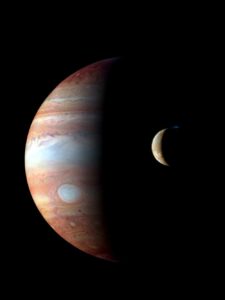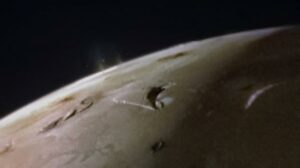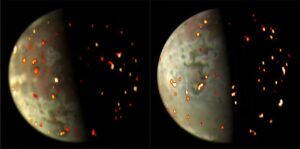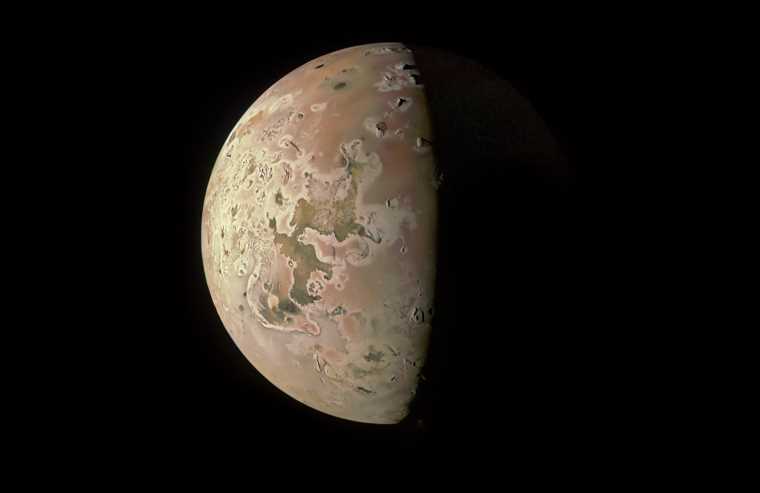A study of Jupiter’s moon Io, where the solar system’s most active volcanoes are located, has revealed an energy-generating process that could support life in the subsurface oceans of the planet’s icy moons. Known as tidal heating, the process generates heat energy when the moon is stretched and pulled by the gravitational forces of its host planet and its other moons.
“Tidal heating plays an important role in the heating and orbital evolution of celestial bodies,” said Alex Hayes, professor of astronomy at Cornell University, in a statement. “It provides the warmth necessary to form and sustain subsurface oceans in the moons around giant planets like Jupiter and Saturn.”


According to the study’s authors, Io’s notoriously ‘hellish landscape’ may be unsuitable for life as we know it. However, its volcanic activity could point to tidal heating, which helps them understand the energy-generating process that could sustain organisms living within the subsurface oceans of Europa, Ganymede, and Calisto.
“Studying the inhospitable landscape of Io’s volcanoes actually inspires science to look for life,” said the study’s lead author, Madeline Pettine, a doctoral student in astronomy at Cornell.
Since interplanetary probes revealed the likelihood of these massive subsurface oceans made up of ordinary seawater hiding below the surface of these frozen space bodies, scientists have been encouraged by the possibility those oceans support biological life. The Debrief recently covered a study of life underneath the icy covering of Earth’s Arctic Ocean and found that even minuscule amounts of sunlight can generate photosynthesis to help life thrive.
Unfortunately, the icy shells encapsulating the oceans of Jupiter’s moon Io and its other icy moons are incredibly thick, making it virtually impossible for sunlight to provide the energy needed for life to grow.


In recent decades, scientists have learned that certain specialized life forms found at the bottom of Earth’s oceans are not only surviving but thriving without any sunlight whatsoever. Dubbed “extremophiles” for the extreme habitats they inhabit, these hardy organisms have learned to use the energy and nutrients released by deep-sea vents that erupt through the ocean floor.
Those vents are likely caused by the tidal heating beneath our planet’s surface. The researchers believe this process may also happen on Io due to the constant forces exerted on Jupiter’s closest moon.
“The gravity from Jupiter is incredibly strong,” Pettine said. “Considering the gravitational interactions with the large planet’s other moons, Io ends up getting bullied, constantly stretched and scrunched up. With that tidal deformation, it creates a lot of internal heat within the moon.”
Curious to see how the moon’s many volcanoes could contribute to generating the energy needed for life to thrive, the researchers studied data captured by NASA’s Juno mission. Specifically, the team focused on data collected by that probe’s Jovian Infrared Auroral Mapper (JIRAM) camera when it flew by Jupiter’s moon Io.
“New Horizons spied 11 different volcanic plumes of varying size, three of which were seen for the first time and one – a spectacular 200-mile-high eruption rising above the volcano Tvashtar – that offered an unprecedented opportunity to trace the structure and motion of the plume as it condensed at high altitude and fell back to the moon’s surface,” explains NASA’s mission website.


According to the published study, that analysis revealed that along with many previously identified volcanoes near the moon’s equatorial region, Io also had volcanoes near its north and south polar regions.
“In the north, a cluster of four volcanoes – Asis, Zal, Tonatiuh, one unnamed and an independent one named Loki – were highly active and persistent with a long history of space mission and ground-based observations,” explains a press release announcing the new study. “A southern group, the volcanoes Kanehekili, Uta, and Laki-Oi, demonstrated strong activity.”
The researchers say they saw the group of northern volcanoes appear to erupt in unison, making them bright enough for Juno to witness the event. The volcanoes even seemed to respond to one another.
“They all got bright and then dim at a comparable pace,” Pettine said. “It’s interesting to see volcanoes and seeing how they respond to each other.
According to the researchers, these polar volcanoes found on Jupiter’s moon, Io, could help regulate tidal heating by causing friction in the moon’s magma interior. They also say the same process could provide energy for life forms living beneath the icy surface of the host planet’s other moons.
The study “JIRAM Observations of Volcanic Flux on Io: Distribution and Comparison to Tidal Heat Flow Models” was published in Geophysical Letters.
Christopher Plain is a Science Fiction and Fantasy novelist and Head Science Writer at The Debrief. Follow and connect with him on X, learn about his books at plainfiction.com, or email him directly at christopher@thedebrief.org.

